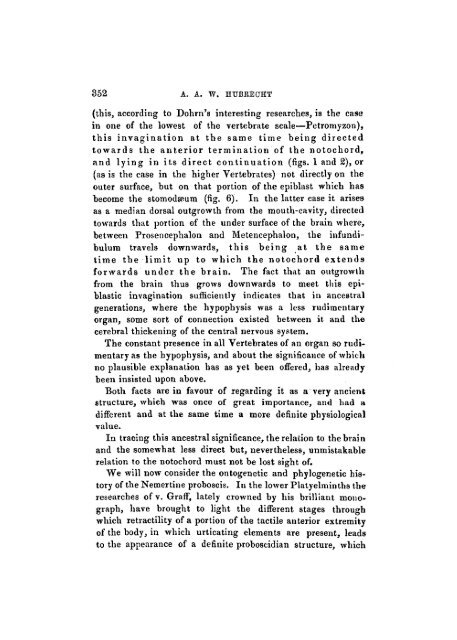On the Ancestral Form of the Chordata.
On the Ancestral Form of the Chordata.
On the Ancestral Form of the Chordata.
You also want an ePaper? Increase the reach of your titles
YUMPU automatically turns print PDFs into web optimized ePapers that Google loves.
352 A. A. W. HTJBJBEOHT<br />
(this, according to Dohrn's interesting researches, is <strong>the</strong> case<br />
in one <strong>of</strong> <strong>the</strong> lowest <strong>of</strong> <strong>the</strong> vertebrate scale—Petromyzon),<br />
this invagination at <strong>the</strong> same time being directed<br />
towards <strong>the</strong> anterior termination <strong>of</strong> <strong>the</strong> notochord,<br />
and lying in its direct continuation (figs. 1 and 2), or<br />
(as is <strong>the</strong> case in <strong>the</strong> higher Vertebrates) not directly on <strong>the</strong><br />
outer surface, but on that portion <strong>of</strong> <strong>the</strong> epiblast which has<br />
become <strong>the</strong> stomodEeum (fig. 6). In <strong>the</strong> latter case it arises<br />
as a median dorsal outgrowth from <strong>the</strong> mouth-cavity, directed<br />
towards that portion <strong>of</strong> <strong>the</strong> under surface <strong>of</strong> <strong>the</strong> brain where,<br />
between Prosencephalon and Metencephalon, <strong>the</strong> infundibulum<br />
travels downwards, this being at <strong>the</strong> same<br />
time <strong>the</strong> limit up to which <strong>the</strong> notochord extends<br />
forwards under <strong>the</strong> brain. The fact that an outgrowth<br />
from <strong>the</strong> brain thus grows downwards to meet this epiblastic<br />
invagination sufficiently indicates that in ancestral<br />
generations, where <strong>the</strong> hypophysis was a less rudimentary<br />
organ, some sort <strong>of</strong> connection existed between it and <strong>the</strong><br />
cerebral thickening <strong>of</strong> <strong>the</strong> central nervous system.<br />
The constant presence in all Vertebrates <strong>of</strong> an organ so rudimentary<br />
as <strong>the</strong> hypophysis, and about <strong>the</strong> significance <strong>of</strong> which<br />
no plausible explanation has as yet been <strong>of</strong>fered, has already<br />
been insisted upon above.<br />
Both facts are in favour <strong>of</strong> regarding it as a very ancient<br />
Structure, which was once <strong>of</strong> great importance, and had a<br />
different and at <strong>the</strong> same time a more definite physiological<br />
value.<br />
In tracing this ancestral significance, <strong>the</strong> relation to <strong>the</strong> brain<br />
and <strong>the</strong> somewhat less direct but, never<strong>the</strong>less, unmistakable<br />
relation to <strong>the</strong> notochord must not be lost sight <strong>of</strong>.<br />
We will now consider <strong>the</strong> ontogenetic and phylogenetic history<br />
<strong>of</strong> <strong>the</strong> Nemertine proboscis. In <strong>the</strong> lower Platyeltninths <strong>the</strong><br />
researches <strong>of</strong> v. Graff, lately crowned by his brilliant monograph,<br />
have brought to light <strong>the</strong> different stages through<br />
which retractility <strong>of</strong> a portion <strong>of</strong> <strong>the</strong> tactile anterior extremity<br />
<strong>of</strong> <strong>the</strong> body, in which urticating elements are present, leads<br />
to <strong>the</strong> appearance <strong>of</strong> a definite proboscidian structure, which

















